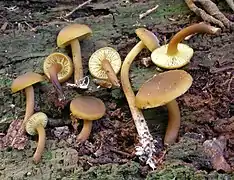| Callistosporium luteo-olivaceum | |
|---|---|
 | |
| Scientific classification | |
| Kingdom: | |
| Division: | |
| Class: | |
| Order: | |
| Family: | |
| Genus: | |
| Species: | C. luteo-olivaceum |
| Binomial name | |
| Callistosporium luteo-olivaceum | |
| Synonyms[1] | |
| |
Callistosporium luteo-olivaceum is a species of agaric fungus in the family Tricholomataceae. It was originally described in 1859 as Agaricus luteo-olivaceus by Miles Joseph Berkeley and Moses Ashley Curtis in 1859. Rolf Singer transferred it to Callistosporium in 1946. The fungus has an extensive synonymy.[1] Although rare, C. luteo-olivaceum is widely distributed in temperate and tropical areas of Europe and North America.[2] In 2014, it was reported growing in pine forests in Western Himalaya, Pakistan.[3] The species is inedible.[4]
The caps are brownish, as are the stipes, which are fibrillose and hollow, with yellowish tomentum near the base.[5] The spores are colorless but produce a yellow color in ammonia.[5]
References
| Callistosporium luteo-olivaceum | |
|---|---|
| Gills on hymenium | |
| Cap is convex | |
| Hymenium is adnate or adnexed | |
| Stipe is bare | |
| Spore print is white | |
| Ecology is saprotrophic | |
| Edibility is unknown | |
- 1 2 "GSD Species Synonymy: Callistosporium luteo-olivaceum (Berk. & M.A. Curtis) Singer". Species Fungorum. CAB International. Retrieved 2014-07-23.
- ↑ Bas C, Kuyper TW, Noordeloos ME (1995). Flora Agaricina Neerlandica – 3. CRC Press. p. 104. ISBN 978-90-5410-616-6.
- ↑ Saba M, Khalid AN (2014). "First report of Callistosporium luteoolivaceum from Western Himalaya, Pakistan". Mycotaxon. 129: 73–77. doi:10.5248/129.73.
- ↑ Miller Jr., Orson K.; Miller, Hope H. (2006). North American Mushrooms: A Field Guide to Edible and Inedible Fungi. Guilford, CN: FalconGuide. p. 159. ISBN 978-0-7627-3109-1.
- 1 2 Trudell, Steve; Ammirati, Joe (2009). Mushrooms of the Pacific Northwest. Timber Press Field Guides. Portland, OR: Timber Press. p. 122. ISBN 978-0-88192-935-5.
External links
This article is issued from Wikipedia. The text is licensed under Creative Commons - Attribution - Sharealike. Additional terms may apply for the media files.